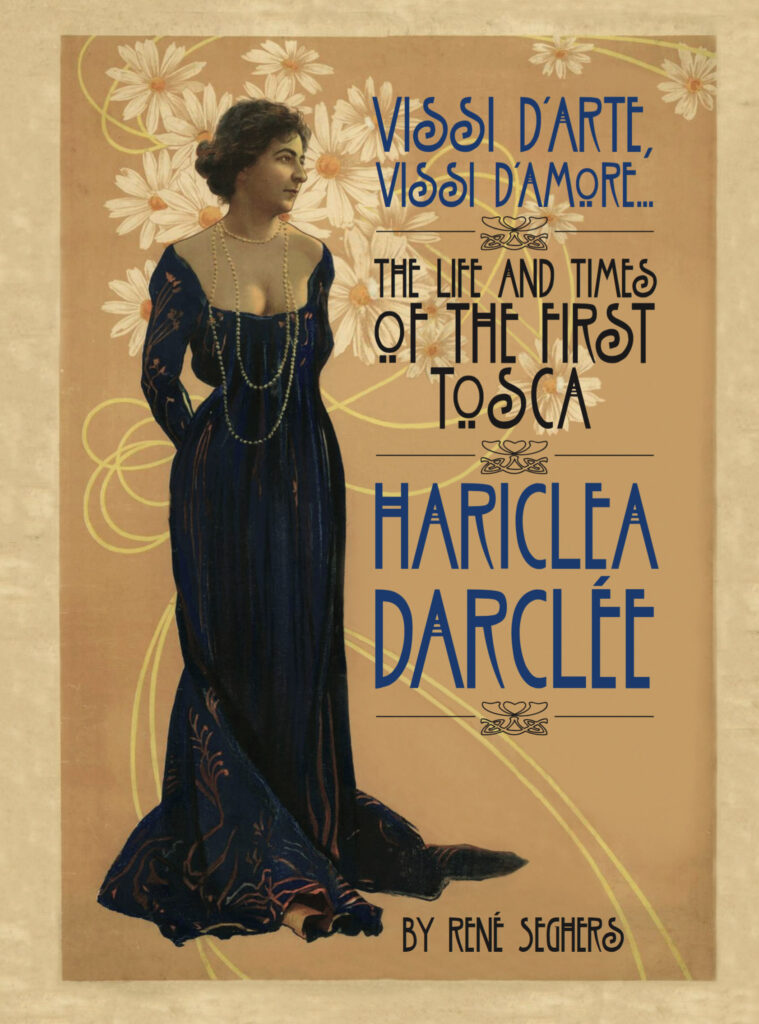
Published at last, René Seghers’s Hariclea Darclée biography!
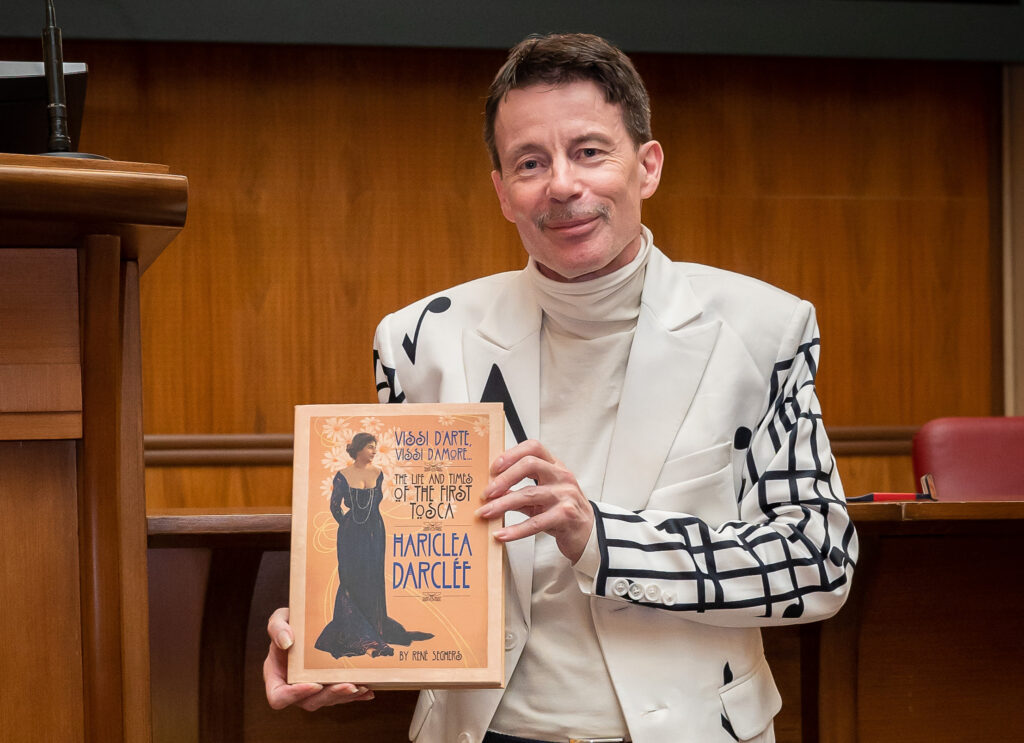
After 25 years and overcoming the falling through of a scheduled 2014 release, author René Seghers did it after all: publish his biography on Hariclea Darclée, the first Tosca, Catalani’s Wally, Mascagni’s Iris and Luisa in I Rantzau and many more! And how: the book is designed as a piece of art in the Art Nouveau style of her time, the print is state of the art and… the 500 page book with over 110 photographs, a 70 page chronology and including a names register is printed in FULL COLOUR ! Seghers: “People asked me many times if in these 25 years I despaired that the book would ever see the light of day, but no. On the contrary. To begin with, it was born out of personal fascination, so I enjoyed every step on the way. The discoveries, the friends made in the process. Moreover, any given setback always resulted in a better book. When Thomas G. Kaufmann and Frank Hamilton died, to both of whom this book is dedicated, I thought all knowledge in the chronology department ended with them. But in 2020 Pippo Martelli stepped in to vastly enhance the chronology once again. Private funding made this limited 100 copies release possible. It was scheduled for an earlier print in 2021, when I discovered novel AI image enhancement programming. Having been a photographer in a previous life I threw myself on AI and postponed the release with another year. In that period I was able to vastly enhance all photographs in the book. On top of that I was able to restore all of them to full colour, making this the first full colour biography of any 19th century singer.”
It is hard to describe the full scope of the Darclée biography in words since, apart from the detailed research the visual aspect of the design by Dick Bak is half of the pleasure. As for the research, this was done on location over the entire production period of 23 years. This is not a copy-paste internet sources biography. Seghers travelled the world in order to visit all the places where she sang, and spent months in Romania, studying her private archives. In the end he actually found the original 78rpm disc, a privately made, one copy only, Gramophone record, which Seghers discographical collaborator Christian Zwarg subsequently was then able to identify and date to the day. With the source missing the attribution had always been questionable, as was the alleged recording date in 1928, when the soprano was 68 years old. With the original 78RPm in his hands the authenticity could be proven and the recording date corrected to 1910, when Darclée was still singing prestigious productions, among them the earliest Italian Rosenkavaliers a revival of Pacini’s Saffo, followed by the world premiere of Saint-Saëns’s revised Proserpine. Seghers also solved the mystery of what happened to her Fonotipia test recordings of arias from her world premieres including Tosca and Iris, but also Traviata and Don Pasquale, the first role treasured by her friend Verdi himself, the second one about to become her trump card in 1905, when she toured Italy with it, thus making it a classic pre-tour promo record, one of the first in its kind, had it been published.
More than just about the lost recordings
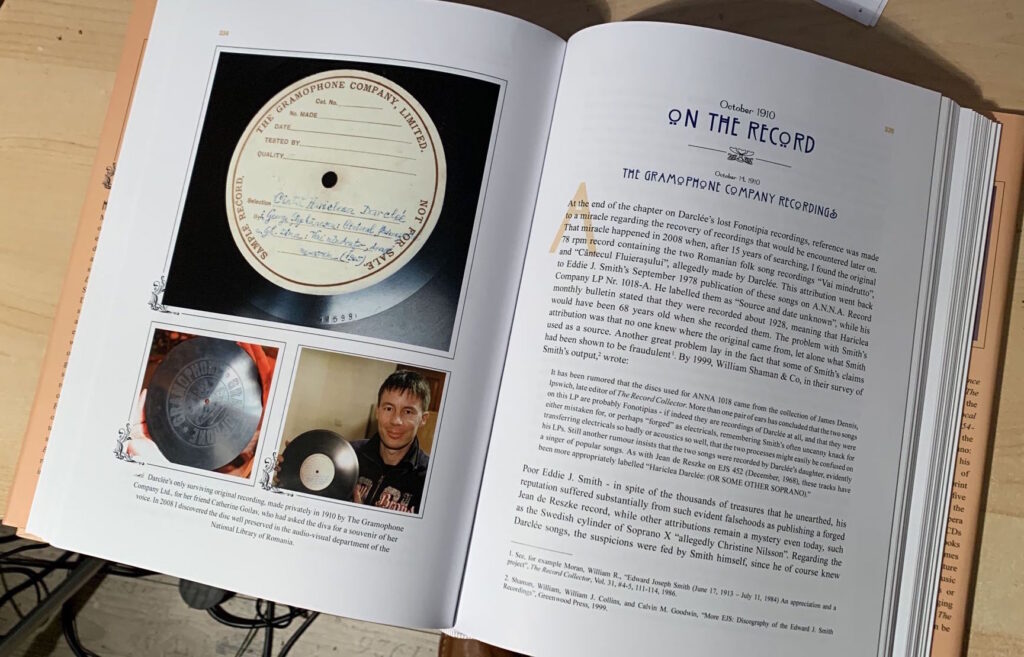
The nebulous mysteries that surround her lost Fonotipia recordings are surely a focus point for many collectors. Although Seghers did not yet find any test pressings of them, the book does include pointers of how to identify a genuine Fonotipia Darclée test pressing (the author still believe they could exist). Apart from that the book takes you through an incredible life from Hariclea’s earliest childhood as a descendent of a royal Greek line, through running off with a womanizing gambler captain, and ultimately fleeing to Paris 1886, pregnant, in a desperate all or nothing attempt to break into a career. On the edge of starvation an agent of the Opéra then literally plucked her from the conservatory class there to create the Grand Opéra version of… Gounod’s Roméo et Juliette! When nerves and a hostile press got the better of her, it was Patti who stepped in and this little mishap ultimately changed her life. Contrary to what the English language Patti biographers tell us, Patti garnered heaps of bad press in Paris (Seghers quotes them, sources included) and when Patti left without trumpets in the night Darclée stepped in triumphantly. Until the end of her career she was billed world wide as “the soprano who hurled Patti out of Paris”, along with quotes from the French press to prove it. She was herself hurled out of Paris too by the way, since Jean De Reszke was envious of Darclée’s success, and young Nelly Melba, who had wanted the rôle herself, plotted against her. She was saved by her compatriot, the impresario Raoul Gunsbourg, who took her to Nice and Petersburg, after which she decided to start all over again fresh yet another time. Not speaking Italian she packed her bags and left for Milan, where another wannabe became her study partner: a certain Ruggero Leoncavallo. Rehearsing on the first floor of some backstreet la Scala’s impresarios overheard the two, knocked on the door and invited her to come over. Sonzogno had hired La Scala for the season on the wings of his unexpected success of Cavalleria Rusticana some months before and they lacked a star soprano for the Italian creation of Massenet’s Le Cid, Gomes’s novelty Côndor/Odalêa… Darclée was hired overnight, billed as “the star of the Paris opera that outsang Patti on her own turf” and following the Cid premiere she became world famous overnight.
Novel insights into verismo
Leoncavallo rehearsed Darclée when she stepped in for Romilda Pantaleoni in La Scalas first Cavalleria Rusticana run and he conducted the work in her subsequent Romanian tour. Six months later Leoncavallo finally had an opera of his own produced… Pagliacci! In this manner the chronology in the book points out numerous hitherto unknown relations between the composers and singers of the day. The study of such premieres as Gomes’s important but forgotten Condôr but also the genesis of La Wally sheds intriguing light on the precise order of the birth of verismo. The book is not merely a Darclée biography but indeed a book on The Life & Times of Darclée, with much attention for the composers and their works. Especially the lesser or completely unknown works are put into the spotlights. La Wally and Mascagni’s Iris are currently on the rise, but Condôr, Vallini’s Il Voto, De Lara’s Amy Robsart, Pachierrotti’s O Eidelberga mia, Panizza’s Aurora, Rubinstein’s Demon, Mancinelli’s Ero e Leandro, Mascagni’s I Rantzau up to Saint-Saëns’s Proserpine are presented here in the proper framework of their time. A point is made for forgotten masterpieces, such as Condôr. Perhaps Amy Robsart isn’t, but it presents a dramatic insight in the dazzling operatic world of Monte-Carlo and the menage-a-trois between prince Albert I, princess Alice and her lover De Lara, whose opera premieres and productions were all financed by her, including the likes of Tamagno, Darclée & co. The book has tons of dedicated photographs by the composers and singers of her day. Some forgotten careers are brought into the light, such as those of Emilio De Marchi and Eugenio Giraldoni, Darclée’s life partners pre and following Tosca, which they created together. Giraldoni’s long thought lost diaries are extensively quoted.
To the rescue

On a banquet in the presence of Verdi following the celebration of Rossini’s 100th birthday, Ricordi spotted a medal on Darclée’s dress that resembled a medal given in Italy to heroes who had rescued someone. When he asked her teasingly whom she had rescued, Darclée, perhaps encouraged by the previous toasts, replied: “Indeed Sir, I rescued La Wally.”
Puccini and Ricordi wanted her to create Manon Lescaut but at the time Darclée couldn’t be bothered by creating a work of a failed composer. When Manon Lescaut triumphed in Turin she left her Madrid obligation behind and stepped in as the heroine in the la Scala run. It was then and there that Puccini envisioned Tosca for Darclée. Incredible are the adventures, the infatuations with King Don Carlo I of Portugal, or Andrès Perello de Segurola, the travelling from places as remote as Moscow to the Brazilian jungle, or Chile. The bankruptcies of tour managers, leaving entire troupes stranded penniless in Argentina or New York, in the infamous Mapleson fiasco. The things artists like Darclée had to overcome in their professional and personal life in a pre-modern world where an Ocean steamer was the equivalent of an airplane today, are near incredible. Much of it would have been sheer unbelievable if Seghers hadn’t backed it up with sound sources – no line is unaccounted for, with footnotes on the pages. An unfathomable work, as he writes himself in the preface, adding that this was only possible with the help of the over one hundred people mentioned in the acknowledgements.
The rise and fall of Hariclea Darclée
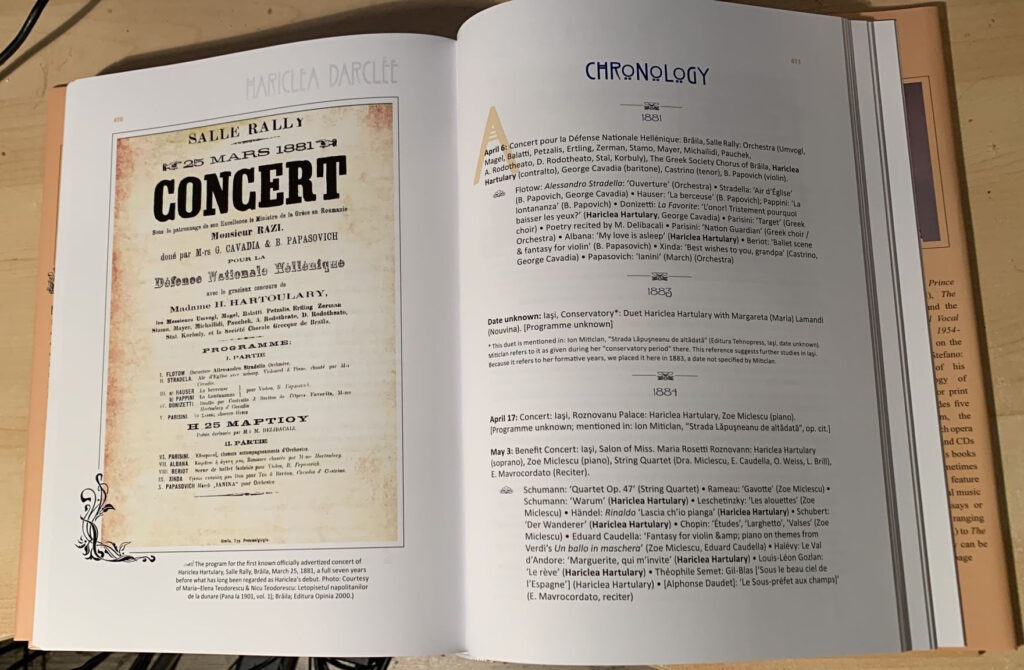
The dust wrapping states that Darclée was the Maria Callas or Anna Netrebko of her day, but that is only true in terms of fame, since Callas nor Netrebko had Catalani, Puccini, Mascagni , Mancinelli and Saint-Saëns compose operas for them. Along with Gemma Bellincioni and perhaps Rosa Raisa (who created Turandot), Darclée was the last great creator of opera. Darclée also sang premieres of Massenet, Wagner, Leoncavallo and others in various countries and continents. Then why do we know so little about her? There are two reasons, the first obviously being the loss of her mentioned Fonotipia creator’s records, although such records did not keep the names of Cesira Ferrani or Angelica Pandolfini in the spotlights. The true reason behind the lights having dimmed on Darclée is that she was the most famous soprano of the opera world (along with Bellincioni) in a time when that world was defined by Italian opera in the Latin hemisphere. Post Tosca and the financial troubles that dimmed the lights on La Scala in the second half of the 1890s, Covent Garden and the Metropolitan Opera House became the two most important theatres of the world. Theatres where, reveal some quoted American publications in Seghers’s book, Jean De Reszke and Nellie Melba, Darclée’s sworn enemies ruled not just on the grounds of their voices, but also on the grounds of being majority share holders, which made them effectively the employers of Maurice Grau & co.
The end
Fascinating as it is to read all that in a book that shakes up many clichés about the era, one should not forget that it is told from the perspective of Darclée’s life, a life that went from triumph to tragedy. As the book advances toward the ending, we can feel increasingly dark shadows fall over the era of Darclée. With many of her royal protectors gone over world war I, her immense fortune dissolved in the war, her son’s operetta productions, bad investment and hopeless lawsuits, the final decades make for increasingly sad reading, until death ended her suffering in 1938, just before the outbreak of yet another World War.
Intriguing are the chapters on Darclée’s legacy, from the first Romanian ghost-written auto-biography to the 1960 movie on her life, celebrating the centennial of her birth, and then in 1995 the beginning of the Hariclea Darclée International Voice Competition.
A record guide to the Era of Darclée
Aided in this by Christian Zwarg, Seghers points from chapter to chapter to recordings of Darclée’s colleagues that recorded, especially when they recorded rôles sung with her on stage. Another focus is given to recordings of the lesser known operas that she appeared in. While some some buffs will know many of these, most people won’t. Few will have heard of the unique cylinder recorded by Jules–Célestien Devoyod, her partner in the European premiere of Glinka’s A life for the Tsar, and so on. Not everyone will have heard of the 1904 Mapleson live recordings recording or the 1970s highlights recording of Mancinelli’s Ero e Leandro, the world premiere excerpts of Pachierotti’s O Eidelberga mia, or 1940s excerpts from Gomes’s Condôr, to name but a few.
Darclée in full colour
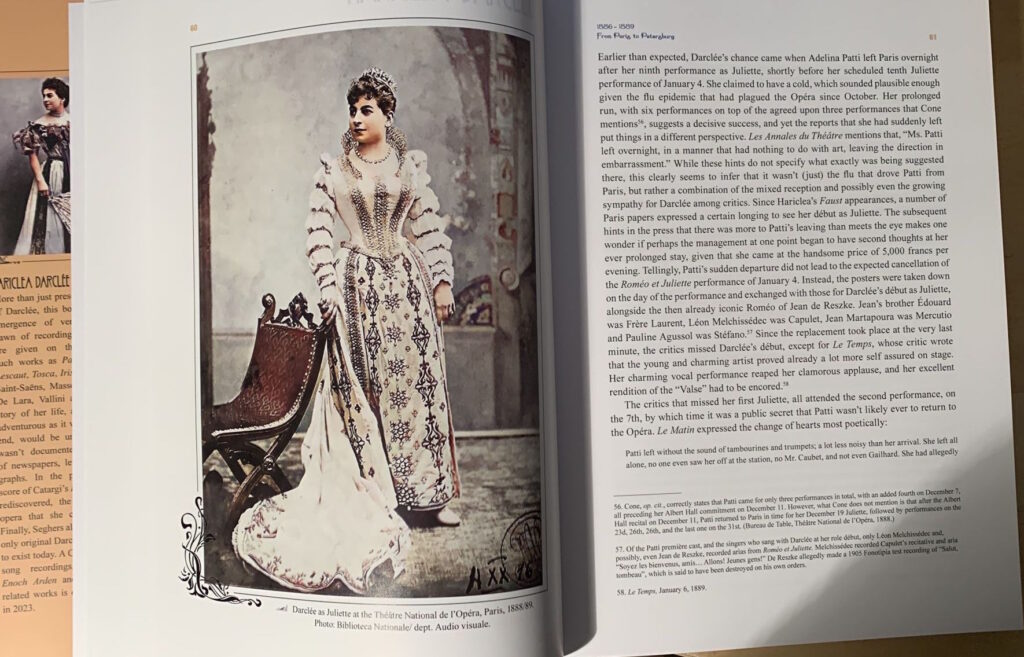
Asked after how Seghers can know the true colours of any given black and white photograph he sais: “People keep asking me that and yet no one ever asked me how a black and white camera can reduce the colourful three dimensional reality into a credible two dimensional black and white photograph. It is simple: if you accept black and white photography it is easy to understand that those greyscales can be reconverted back to their original colours. In fact, today true to life images can be produced from not just Greek and Roman statues, but even from Egyptian tombs. It just takes an incredible amount of programming power and Photoshop or 3D programming experience to do that. Along with time. Some photos took me an hour, others three days.”
Missing links from Vallini’s Il Voto to Catargi’s Enoch Arden

There are two missing links in the discography of her creations: Darclée’s world premieres of Vallini’s Il Voto (1894) and Alexis Catargi’s Enoch Arden (the first Romanian opera, created by Darclée in 1906). The score of Vallini’s opera is apparently lost, but Seghers retraced the orchestra score of Catargi’s long thought lost Enoch Arden. Unfortunately, the steep rise in costs to make this print come to life prevented the immediate recording of highlights of Darclée’s complete part from Enoch Arden including all duets. This is currently being prepared for 2023. Seghers: “If we get the recording project financed that is, we’re currently € 7000 short. Any support is welcome. I know this sounds silly but it is in this unusual manner that the Darclée book eventually found private funding through people with heart. What I can guarantee is that the music will surprise. I had no expectations at first since Catargi was a so called ‘amateur’ composer. When I heard the music I came to realise that ‘amateur composer’ then had a completely different connotation than the present one. It merely meant that the composer, usually and also in this case of nobility, did not make a living composing. Catargi obviously had the highest training and free from the need of any commercial compromise he created visionary, unconventional verismo music. The music is both incredibly beautiful and highly romantic, but in many declamatory vocal passages also looking ahead of its time to Elektra, to Turandot… At the launch of the book in Bucharest on May 29 the audience was stunned by Barbara Schilstra’s rendition of Annie Lee’s great Act II dream scene “O mio crudo martirio… O sposo mio.” The book launch also secured us the performance of the complete work on the stage of the National opera Bucharest in 2024. I will reconstruct the missing pages of the libretto which Maestro Daniel Jinga will set to music in Catargi’s style. I promise nothing short of a sensation, which is obvious to those who read the corresponding chapter in my Darclée biography.”
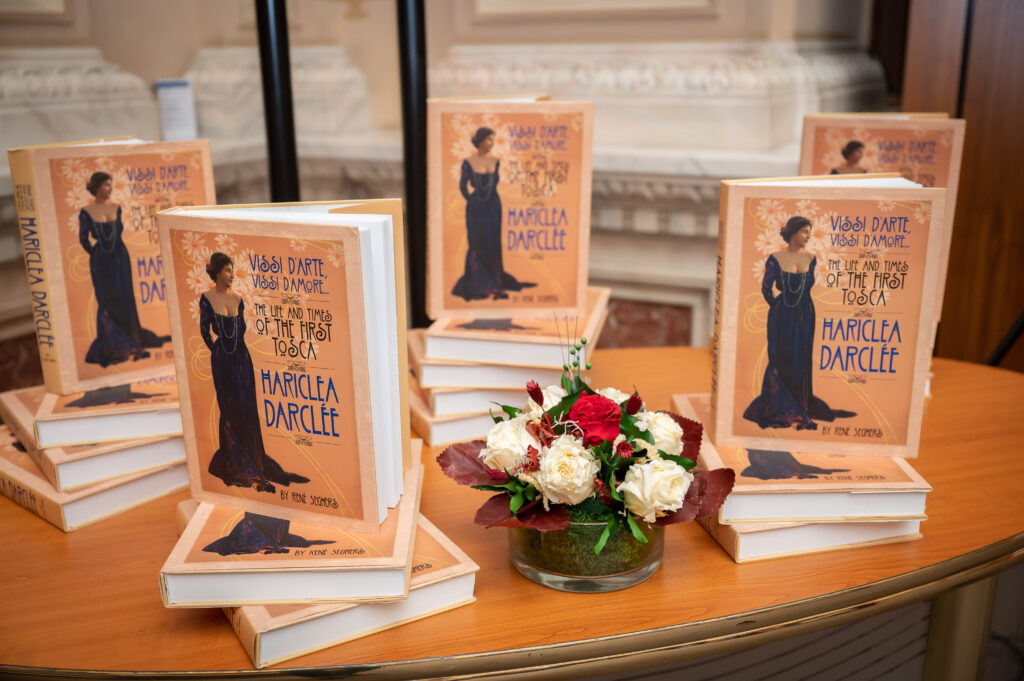
Ordering details
The limited edition costs € 125 including registered shipping in Europe. Those who want to order it can email the author at rene@reneseghers.nl, and inquire about availability. Seghers: the first non profit edition is currently sold out. There is going to be a second edition, those interested can mail the author for pre subscriptions. Distribution in the USA is done with Tamino Autographs” See also www.Darclee.com.
The book presentation
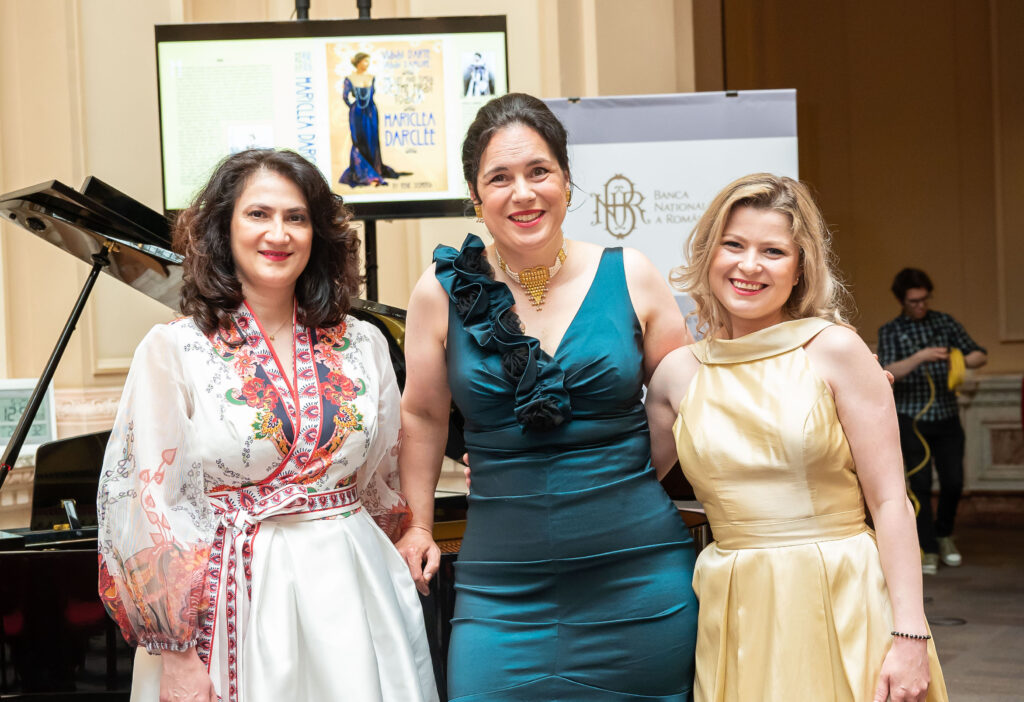
The SensoTV.ro film report of Mr. Seghers’s Darclée biography presentation in the National Bank of Romania had an elite audience. Among the speakers were Mr. Daniel Jinga of the Bucharest National Opera, with whom mr. Seghers will perform his rediscovery of the once thought lost Enoch Arden score (by Catargi) that Darclée created in 1906. The premiere is planned for 2024, the Puccini year. Also speaking was the vice major of Braila, Doinita Ciocan, with whom Mr. Seghers is planning to work together on a presentation of the Romanian language edition of the book, likewise in 2024. Offers for a televison movie based on the biography will shortly be discussed. An accompanying CD to the biography with countless surprises is in the making. At the presentation a movie was shown, shot by Mr. Seghers, of his 2007 discovery of the only true 78RPM record of Darclée. Madalina Barbu sang songs dedicated to Darclée, soprano Barbara Schilstra sang the central Act II dream scene of Enoch Arden. Excerpts of both are in the SensoTV report, which can be seen here:
Rudi van den Bulck, June 2023